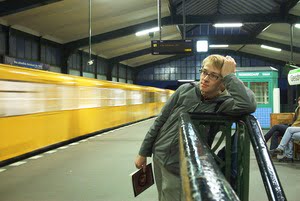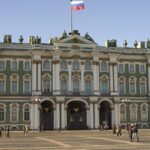I spent two summers in St. Petersburg as a part of a study abroad program. While I was there, I discovered a few out of the ordinary spots to visit not found in the Intourist guide book.
Today it is known as St. Petersburg, located in the Russian Province, this storied city has a long history. Originally named for Tsar Peter the Great, who wanted a modern cosmopolitan city to resemble those in the west and more specifically France. Over the years St. Petersburg has also been called Petrograd and Leningrad. After the fall of the Berlin Wall and Communist rule the city once again took the ancient name of St. Petersburg. During the days of Tsar Peter the Great the city of St. Petersburg was the seat of the Tsar’s rule. The sprawling city that greets visitors today is much different than the city envisioned by Tsar Peter the Great; although some of those ancient buildings still stand and are in use today. Like many cities in Europe St. Petersburg has an excellent pubic transportations system with buses, trolley buses, trolleys, and the Metro making it fairly easy for residents and visitors alike to get about the city. A word of caution on taking the local taxi service; most taxis are just private citizens who stop at the sign of a raised arm. Riding with a local driver is like taking a ride at the local amusement park; any open space not containing a pot hole is fair game – including the sidewalk. If taking a taxi be prepared for a wild ride. Some of the Metro stations themselves are works of art that are easily overlooked.
St. Petersburg is a city with over five million residents. Once named for the Communist leader Lenin, little remains of the city under Communist rule where once stood red flags adorned with the hammer and sickle and statues of Lenin were erected every few blocks throughout the city. When Communism fell so did the statues. The old flags have been replaced with the blue, white, and red tricolour of Russia. Sometimes referred to as the Venice of the north St. Petersburg is built on 24 islands with 42 waterways including the Neva River. For the night owl and nocturnal tourist a trip along the river between two and five o’clock in the morning will allow for a sight seen at no other time. If you haven’t gotten where you wanted to go by 2am then you aren’t going to get there until after 5am when the bridges are once again lowered. It is between these hours that all of the brdges along the river and waterways are raised so that any shipping traffic may pass unimpeded. It is a must see for anyone looking for something out of the ordinary who has seen enough painted frescoes on cathedral walls or tourist shops. St.
Petersburg lies a short distance south of the Arctic Circle so for a couple of weeks on either side of the summer soltice the residents experience Bela Noch (white nights) where the sun doesn’t quite fully set; and it is during this time that a visitor can fully view and appreciate the sight of the continual line of ships passing along the river. And if one is luck they might even glimpse a naval vessel among the passing ships. For anyone who has lived too far south to experience a time when it is possible to never see the sun set – whether it be from the sun just not setting or from the person going to bed before it would set and getting up after the sun has risen – it is a rather unusual experience that for some takes a bit of getting used to.
For the art lover a trip to the Hermitage – formerly the Winter Palace for the Tsars and Tsarinas – is no longer a residence but a vast museum with artifacts dating back to Peter the Great. The collections filling the Hermitage include artistic works from Russian artisans and the masters like Michaelangelo. The collection of artwork, sculptures, and artifacts contained withing the Hermitage is so vast that if a person spent 24 hours a day seven days a week for 10 years they still would not have seen all that is contained within the walls of the old palace. Located along the Neva River the view outside the palace is also worth taking in. Often times when a filmmaker wishes to show his audience that the scene is taking place in St. Petersburg, he uses a shot of the Hermitage for this purpose; and it is a view from the Neva River that is used. But the Hermitage is not the only palace in the city nor is it the only museum. Despite the image of a poor dirty city, St Petersburg is a very cultured city with numerous parks, museums, theatres, and churches.
For the history enthusiast, further along the river lies the Peter and Paul Fortress which is an old garrison which houses a mock up of the stockade located inside complete with life sized mannequins of the gendarmes in full uniform. One of the cells is left open and “furnished” as it was so that visitors can see what it was like for prisoners in the stockade. The walls of the cells were thick concrete so that communication with a fellow prisoner was nearly impossible to achieve. Also within the walls of the Fortress is a cathedral where the tombs of a number of the former Tsars and Tsarinas are located including Peter the Great and Catherine the Great. Besides
the historical sites withing the Fortress lies the mint where Russian money is printed. No visitors are allowed near the mint.
Literature buffs will recognise St. Petersburg as the site used by Feodor Dostoevsky as the location for some of his works; most notably “Crime and Punishment”. While some of the locations have changed, it is still possible to walk the streets and see the spots where Raskolnikov traveled withing the city. The site of the Haymaker Market is now a Metro station but the grounds where the merchants once plied their wares is now a vast concrete plaza where a different group of merchants can be found hawking their wares. The address where Raskolnikov lived still stands and is still a building of flats. Walking along the streets of St. Petersburg in the area in which “Crime and Punishment” occurred gives a whole new perspective to the story. At times it is even possible to imagine Raskolnikov as if he were walking along beside you, even if he never really existed.
For those visitors who love music, the theatres, symphony halls, and ballet productions are fairly inexpensive; but it is the streets of the city that are filled with music. Both above and below young musicians are abound playing for whatever they can receive from the passerby and thrown into a hat. In Russia part time work for teens, college students, and even young adults is non-existent so they make do with whatever they can find and music is sometimes the answer. The young musicians are frequently quite good and well worth the time to stop and listen. For the younger generations mention the Beatles and many people will not know who the famous mop top who changed musical history are, but in Russian the Beatles are still very popular and a favourite for these street musicians. Often times the musicians will not know how to speak any English but they can sing the lyrics to Beatles songs quite well. Classical music abounds in the theatres; but on the street it’s mostly the Beatles or jazz. The most famous ballet theatre in Russia is the Bolshoi which is located in Moscow; but in St. Petersburg there is the Kirov Theatre whose decorative interior is as breath taking as some of productions that take place on the stage. And since each group only plays for two or three hours it is very possible to see and hear quite a few bands during an afternoon stroll along the streets of St. Petersburg.
For the shopper there is as much to buy from street vendors than there is in
the stores – sometimes more. A stroll along Nevsky Prospekt is a shopper’s delight with its near bizarre type atmosphere. The stores themselves are sometimes hidden behind nondescript doors; a shopping spree can sometimes take on the look of a scavenger hunt ending in a child like delight at finding some hidden treasure. Compared to some English speaking countries items like clothing is rather inexpensive for visitors. A stroll along a busy street lined with tall drab concrete buildings can suddenly give way to a park with a beautiful landscape of flowers and trees. At times a group of children squealing happily as they play ball.
While visiting the local cemetery may sound rather morbid and the last place on a tourist’s list of places to see, but the cemetery Alexander Nevsky is a treasure of its own. The cemetery is divided into sections with certain types of people in each one. For instance there is a poets section and a musicians section where the graves of some of Russia’s most famous composers are laid to rest. One such musician even has a piece from one of his compositions carved on his gravestone. While not in Alexander Nevsky St. Petersburg is also the burial site for the Romanov family. The Romanovs – also known as the Tsar Nicholas II and his family – were the last ruling class in Russian before the Bolshevik Revolution in 1917 when the family was reportedly killed.
Many of St. Petersburg’s houses of worship are open to the public, even if a service is taking place. Respectful visitors are welcome. Many of these buildings have artwork that is hundreds of years old. Granted religion was frowned upon under Communist rule, but these buildings are once again being used. In St. Petersburg and in Russia the predominant religion is the Russian (Eastern) Orthodox whose buildings are as much an art gallery as they are a church. One such establishment that did not close during Communist rule was the lone Synagogue. Located near the Kirov Theatre the Synagogue complex has stood for over 100 years and is still being used.
St. Petersburg, like all of Russia, has a culture all its own. Located only an hour’s flight from Helsinki, Finland and a part of the European continent; yet it can seem like a world away. The language of the Russian people is Cyrillic and only vaguely resembles the Arabic letters of the English language. Traditions about the roles of men and women are far behind that seen in modern cities around the world. St. Petersburg (and Russia) is a man’s world where a woman is supposed to know her place. And only the “ladies of the street” wear revealing outfits. In St. Petersburg mundane tasks like finding and using a toilet can be a bit of an adventure. Where is it? What will it be like? And so forth. After a few weeks in the city, it became quite the joke. For those who are not afraid to try something new, eating in a local restaurant can be adventurous. We knew it was meat – beef of some kind – but what was a mystery. All very good, just not sure exactly what.
Like all cities that cater to tourists there are a plethora of tours and tour guides available; but for the visitor who wishes to see the city on his or her own terms, to pick and choose the sites to see; St. Petersburg has much to offer. A visitor with only a few hours to spare must first decide what kind of things they want to see. St. Petersburg is not one of those places where you can see it all in one afternoon. Even Superman with his enormous speed would find it hard to accomplish such a task.



